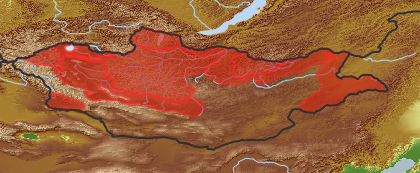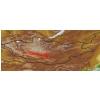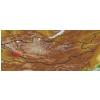| Class: | angiosperms |
| Order: | Lamiales |
| Family: | Scrophulariaceae |
| Genus: | Limosella |
| Scientific name: | Limosella aquatica L. |
| Name acc. to: | Gubanov 1996 |
| Herbar: | list records    |
| Description: | Aquatic acaulescent caespitose dwarf herb, 2-5 cm high. Leaves in radical rosette, long petiolate several times longer than blade, blade 3-15 x 1-5 mm with entire margin. Flowers solitary, pink, short pedicellate. Corolla regular, campanulate, 5-lobed, with short tube. Stamens 4, equal, inserted near middle of corolla tube. Capsule indistinctly dehiscent, about 3 mm long. Seeds numerous, 0.7-0.8 mm long; seed coat rugose. |
| Comments: | The species is widely distributed in mud banks in the floodplains of the Mongolian rivers, classify the Juncus bufonius-Limosella aquatica community (Hilbig 1995).
|
| Link to Flora of China: | http://www.efloras.org/browse.aspx?flora_id=2&name_str=Limosella+aquatica |
| open map in a new window |  |
| Habitat: | Damp muddy river banks and lake coasts (Grubov 2001). |
| Habit (i)general appearance of a plant | |
| Growth form: (i)Herb, shrub, tree or climber. | annual (i)Completing its life cycle within one year or one growing season; roots weak and thin
herb (i)Herbaceous, erect plant, up to 2m high, mostly with a leafy shoot; if perennial, shoots die to the ground each season, shoots are not woody
example: Artemisia pectinata   inherited by family Scrophulariaceae: herb inherited by family Scrophulariaceae: herb
|
| Special growth forms or habits: | rosette plant (i)All or nearly all leaves in a basal rosette, only inflorescences on erect stalks, these without or with much smaller leaves
example: Primula farinosa   inherited by genus Limosella: rosette plant inherited by genus Limosella: rosette plant
creeper (i)Low, mat-forming herbaceous plant, growing along the surface of the ground or just beneath the surface with rhizomes like a mat
example: Potentilla anserina, Lycopodium annotinum 
|
| Size of plant: (i)Attention: use flowering or fruiting specimens to assess plant height (many biennial plants possess only a basal rosette in the first year). | to 100 mm  inherited by genus Limosella: inherited by genus Limosella:
|
| Parasite status: (i)Is the plant a half- or full parasite? | no parasite/saprophyte (i)Plant fully autonomous, leaves with chlorophyll
example: Most plants, Ranunculus  inherited by genus Limosella: no parasite/saprophyte inherited by genus Limosella: no parasite/saprophyte
|
| Water or terrestrial plant: (i)Where do the plants grow? | water or swamp plant  inherited by genus Limosella: water or swamp plant inherited by genus Limosella: water or swamp plant
plants in swamps, marshes or bogs, leaves rising above water (i)Semiaquatic; plant terrestrial, but restricted to wet or moistured environments with ground water at or near the surface
example: Phragmites communis  inherited by genus Limosella: plants in swamps, marshes or bogs, leaves rising above water inherited by genus Limosella: plants in swamps, marshes or bogs, leaves rising above water
|
| Leaf (i)expanded, usually photosynthetic organ of a plant (including phylloclades) | |
| Leaf development: (i)Structure and development of leaves. | flattened blade (i)Cross-section of lamina flat, plain  inherited by genus Limosella: flattened blade inherited by genus Limosella: flattened blade
common leaf (i)Green, often divided in blade and petiole
example: Cotoneaster  inherited by genus Limosella: common leaf inherited by genus Limosella: common leaf
with green leaves (i)Plant with green leaves  inherited by family Scrophulariaceae: with green leaves inherited by family Scrophulariaceae: with green leaves
fleshy leaf (i)Leaves more or less thick, juicy, terete or flat
example: Crassulaceae
|
| Leaf arrangement: (i)Arrangement of leaves at the stem. | basal rosette (i)Leaves positioned at the base of the stem; stem often without leaves, no visible internodes (but flowers often on erect stems, and these may have few leaves)
example: Limonium, Potentilla, Plantago; also used in Liliales with basaly crouwded leaves (Tofieldia, Zigadenus etc.)   inherited by genus Limosella: basal rosette inherited by genus Limosella: basal rosette
|
| Simple or divided leaves: (i)Are the leaves simple or completely divided in several parts? Blade of the leaf entire or (more or less) deeply dissected. Attention: There are various appearances of the leaf margin (from entire to toothed and lobed). Here, we ignore this and ask only for dissections that separate the leaf for more than one third of its length or width, whatever is smaller. Sometimes, it is difficult to tell apart compound leaves from a shoot system with simple leaves: look for stipulae and/or axillary buds at the ground of the leaves: if only some possess these structures, the others are most likely leaflets of a compound leaf. | simple (i)Non-divided leaf, but margin may be incised nearly to the ground   inherited by genus Limosella: simple inherited by genus Limosella: simple
|
| Shape of blade: (i)Easy for simple leaves. In compound leaves use the general shape of leaflet. Always check the ground for largest leaves of a plant. To be worked out: how to handle pinnate leaves? | elliptic (including ovate and obovate) (i)Elliptic: broadest at the middle and narrower at the two equal ends; ovate: egg-shaped, attached at the broad end; obovate: attached at the narrower end
example: Limosella aquatica   inherited by genus Limosella: elliptic (including ovate and obovate) inherited by genus Limosella: elliptic (including ovate and obovate)
linear incl.grasslike or oblong (i)Leaves more than two times longer than broad with more or less parallel margins; see character: stipule for ligula
example: Dracocephalum ruyschiana, Poaceae, Scutellaria scordifolia, Pinus   inherited by genus Limosella: linear incl.grasslike or oblong inherited by genus Limosella: linear incl.grasslike or oblong
|
| Length of leaves: (i)How long is the leaf, be carefull in compound leaves, measure the complete leaf. | from 11 mm to 20 mm  inherited by genus Limosella: inherited by genus Limosella:
from 21 mm to 50 mm
more than 50 mm
|
| Leaf apex: (i)Appearance of the tip of leaf resp. leaflets in compound leaves. | obtuse (i)Sides coming together at the apex at an angle greater than 90 degrees
example: Fallopia convolvulus 
|
| Leaf margin: (i)Structure of leaf margin (or that of a leaflet in case of compound leaves). Attention: Here we ask for the leaf margin, defined as all those dissections that separate the leaf for less than one third of its length or width, whatever is smaller. To be worked out: how to handle margin of pinnate leaves? | entire (i)Plain margin, not toothed
example: Iris   inherited by genus Limosella: entire inherited by genus Limosella: entire
|
| Leaf base: (i)The angle the leaf blade forms with a real or imaginary (sessile leaves) petiole. Attention: Here, we consider only the base of leaves or leaflets (in case of compound leaves). | narrow (i)Angle < 30°   inherited by genus Limosella: narrow inherited by genus Limosella: narrow
|
| Petiole: (i)Leaf divided into stalk (petiole) and blade. | with (i)Leaves with petiole (stalk)   inherited by genus Limosella: with inherited by genus Limosella: with
longer than blade (i)Petiole longer than leaf blade  inherited by genus Limosella: longer than blade inherited by genus Limosella: longer than blade
|
| Stipule: (i)Leaflets at the base of the petiole, these are smaller and of different shape. | none (i)Without stipules
example: Euphorbia, Ericaceae s.l.
|
| Leaf colour upper side: (i)Shades of green on the leaf, upper side. | green (i)Clear green
example: Tribulus terrestris
|
| Leaf colour lower side: (i)Shades of green on the leaf, lower side. | green (i)Clear green, in most species
example: Angelica decurrens
|
| Leaf veination: (i)Arrangement of the main veins of a leaf. | pinnate (i)One main vein, several side veins, sometimes inconspicuous
example: Cicerbita   
|
| Flower (i)reproductive portion of the plant, consisting of sepals, petals, stamens, and pistils | |
| Flower appearance and pollination: (i)General appearance of the flower. | attractive, animal-pollinated (i)attractive and coloured flowers, mostly large, attracting surely animals
example: Trollius, Rosa, Chamaerhodos  inherited by family Scrophulariaceae: attractive, animal-pollinated inherited by family Scrophulariaceae: attractive, animal-pollinated
|
| Flower colour: (i)Attention: assess colour of the most colourful parts of the flower, but not of the stamens; be aware of single plants with a mutation (mostly white) on flower colour. | white (i)Most plants of the population white
example: Pleurospermum, Maianthemum
pink (i)Between red and white
example: Centaurium  inherited by genus Limosella: pink inherited by genus Limosella: pink
|
| Perianth arrangement: (i)Attention: in some plants, flowers may be dimorphic in different ways (dioecious or gynodioecious). If flowers vary, record the characters of the most showy flowers. | double, different (i)Two types of perianth leaves, differently coloured (sepals: outer periant leaves, usually greenish, and petals: inner perianth leaves, usually coloured)
example: Parnassia    inherited by family Scrophulariaceae: double, different inherited by family Scrophulariaceae: double, different
|
| Diameter of flower: (i)Diameter of flower or flower head. | to 5 mm (i)
example: Aruncus
|
| Length of flower: (i)For zygomorphic flowers only, instead of diameter of flower. | from 10 mm to 20 mm  inherited by genus Limosella: inherited by genus Limosella:
|
| Flower symmetry: (i)Symmetry of the perianth leaves. Attention: to assess this character, look on sepals, petals and stamens, but neglect carpels and ovary. | radiary, regular (actinomorphic) (i)More than two axis of symmetry
example: Saxifraga: 5; Iris: 3 
|
| Flower form: (i)common forms of flowers ? Veronica | campanulate (i)Petals united to a bell-shaped corolla   inherited by genus Limosella: campanulate inherited by genus Limosella: campanulate
|
| Sepal number: (i)Number of sepal leaves (outer perianth leaves, calyx leaves, mostly greenish). Attention, this character applies only for flowers separated in sepals and petals, thus excluding most monocots. Be aware of the bracts (involucral leaves) of Asteraceae flowerheads, do not qualify these as sepals! Be also aware in Rosaceae is often an epicalyx developed, in this case count all parts. | 5 (i)
example: Polemonium
|
| Sepal fusion: (i)To which degree are the sepal leaves connected? Attention, this character applies only for flowers separated in sepals and petals, thus excluding most monocots. Be aware of the bracts (involucral leaves) of Asteraceae flowerheads, do not qualify these as sepals! | fused (i)Leaves united, only tips are free
example: Fabaceae, Silene  
|
| Petal / Tepal number: (i)Number of petal leaves (inner perianth leaves, usually coloured). | 5 (i)
example: Potentilla  inherited by genus Limosella: 5 inherited by genus Limosella: 5
|
| Petal / Tepal fusion: (i)To which degree are the petal leaves connected? Petals sympetalous. | fused (i)petal leaves united, only tips are free (gamopetalous, sympetalous)
example: Linnaea, Adenophora, Stellera  inherited by family Scrophulariaceae: fused inherited by family Scrophulariaceae: fused
|
| Spur: (i)A hollow, slender, sac-like appendage of the perianth leaves, storing nectar. | no spur (i)Flower without appendage
example: Peganum
|
| Stamen number: (i)Attention: We ask for the reproductive organs of the flower dispersing pollen. Count only fully fertile stamens, not staminodia (e.g. Parnassia). | 4 (i)Extremely rare, may be absent
example: Plantago
|
| Stamen fusion: (i)To which degree are the stamens fused? Attention: Whereas the pollen sacs itself are often free., their stalks (filaments) may be fused. Here, we count them as fused if they are together over at least one thirth of their length. | fused with a corolla (calyx in Thymelaeaceae) (i)Stamens with perianth leaves at least one third of the length of the filament
example: Orobanche, Salvia, Stellera  inherited by family Scrophulariaceae: fused with a corolla (calyx in Thymelaeaceae) inherited by family Scrophulariaceae: fused with a corolla (calyx in Thymelaeaceae)
|
| Pistil number: (i)Number of pistils (female floral organs: style, if developed; stigma and carpels/ovary together build the pistil). | 1 (i)One carpel, but clearly one stigma
example: Pyrola, Primula, Alyssum
|
| Carpel number: (i)Number of carpels (carpel: forming a simple pistil or part of a compound pistil, modified leaf). | 2  inherited by family Scrophulariaceae: 2 inherited by family Scrophulariaceae: 2
|
| Carpel fusion: (i)To which degree are the carpels (modified leaf forming simple pistil or part of a compound pistil) fused. | fused (i)Carpels united into an ovary, only styles are free
example: Malus, Berberis
|
| Style number: (i)Portion of the pistil connecting the stigma to the ovary. | 1  inherited by family Scrophulariaceae: 1 inherited by family Scrophulariaceae: 1
|
| Stigma number per style: (i)Number of stigmas per style. | 1 (i)One stigma, sessile or with a developed style
|
| Ovary position: (i)For entirely or partly fused carpels, describe their position in relation to the insertion point of perianth leaves (best done by doing a longitudinal section of a flower). | superior (hypogynous) (i)Base of carpels attached above insertion point of perianth leaves, carpels free or fused
example: Delphinium, Anemone    inherited by family Scrophulariaceae: superior (hypogynous) inherited by family Scrophulariaceae: superior (hypogynous)
|
| Sex: (i)Distribution of male and female organs among flowers, only most commonly cases. | bisexual, hermaphrodite (i)All or nearly all flowers of a plant with male and female parts
example: Haplophyllum, Chenopodium  inherited by family Scrophulariaceae: bisexual, hermaphrodite inherited by family Scrophulariaceae: bisexual, hermaphrodite
|
| Inflorescence (i)flowering part of a plant, describes the arrangement of the flowers on the flowering axis | |
| Inflorescence: (i)Structure of the inflorescence. | Solitary flowers (i)Each flower grows on an own leafy stem there may be more than one, if the plant has many leafy shoots
example: Viola, Saxifraga hirculus, Rubus arcticus  inherited by genus Limosella: Solitary flowers inherited by genus Limosella: Solitary flowers
|
| Appearance: (i)Outer look of the inflorescence. | axillary (i)Usually several inflorescences in axillary shoots or single flowers in leaf axils, main shoot remains mostly leafy
example: Tragopogon, Aconogonon
|
| Fruit (i)the seed bearing organ, with or without adnate parts; a ripened ovary and any other structures which are attached and ripen with it. Aggregate fruits are handled like simple fruits for determination. | |
| Consistency: (i)Fleshy fruits or dry fruits, see dispersal adaptations for further classification. | dry (i)With a dry outer shell, no fleshy parts, but seed (embryo) could be edible  inherited by family Scrophulariaceae: dry inherited by family Scrophulariaceae: dry
|
| Type of fruit: (i)Common fruit types (including pseudocarp). | Solitary fruits (i)     inherited by family Scrophulariaceae: Solitary fruits inherited by family Scrophulariaceae: Solitary fruits
capsule (i)Dry dehiscent fruit, releasing seeds by slits or holes.
example: Poppy, most Caryophyllaceae, Cerastium, a lot of Scrophulariaceae, Iris (oppened capsule looks like Delphinium), Zygophyllum - it is a very common fruit type     inherited by family Scrophulariaceae: capsule inherited by family Scrophulariaceae: capsule
Dehiscent fruits (i)Fruits open along a longitudinale line (except silicula)  inherited by family Scrophulariaceae: Dehiscent fruits inherited by family Scrophulariaceae: Dehiscent fruits
|
| Opening of fruit: (i)Mode of dehiscence at maturity to release seeds. | opening along dehiscent line (i)Opening along a preformed line
example: Vicia, Lathyrus: pods
opening / dehiscent (i)Dry? Fruits opening with different types
|
| Size of fruit: (i)Size of the fruit including appendage. | to 5 mm (i)
example: Halerpestes: many folicles forming dry nutlets
|
| Dispersal: (i)Appearance of fruit or seed (if single) and adaptations to dispersal. | Otherwise (i)All parts dry, no conspicuous adaptations
|
| Hairs | |
| Has hairs?: | no hairs, glabrous
|
| Shoot/Stem (i)a young stem or branch | |
| Spines, thorns or prickles: (i)Shoot with conspicuous spines, thorns or prickles. | absent (i)Stem glabrous or hairy, but never with spines, thornes or prickles
example: Gentiana barbata
|
| Root / shoot below ground (i)plant part below ground (in most cases), including below ground shoots, without leaves | |
| Root type: (i)Organisation of the roots. | allorhizous (i)Plant with a conspicuous tap root, one larger tap root with side roots
example: Dicotyledonae  inherited by order Lamiales: allorhizous inherited by order Lamiales: allorhizous
|
| Runners: (i)Plant must be excavated; shoots, subterranean shoots connected by runners. | stolons (i)Plants creep with above-ground shoots (stolons) which can root and establish new plants
example: Potentilla arenaria, P. anserina 
|
| Storage in below-ground structures: (i)Rhizomes or bulbs. | none (i)Plant with non-thickened roots, their maximum diameter does not exceed the diameter of the shoot base
example: Anabasis brevifolia
|
| Distribution (i)region where the plant is likely to be found | |
| Distribution (Veg. Zones): (i)acc. to Grubov 1952 | Khubsgul (i)In distribution data often named as '1' 
Khentei (i)In distribution data often named as '2' 
Khangai (i)In distribution data often named as '3' 
Mongol-Daurian (i)In distribution data often named as '4' 
Khobdo (i)In distribution data often named as '6' 
East Mongolia (i)In distribution data often named as '9' 
Depression of Great Lakes (i)In distribution data often named as '10' 
Valley of Lakes (i)In distribution data often named as '11' 
Dzungarian Gobi (i)In distribution data often named as '14' 
|
| Distribution Khangay: (i)acc. Flora Khangaya 1989 | I
IV
V
|